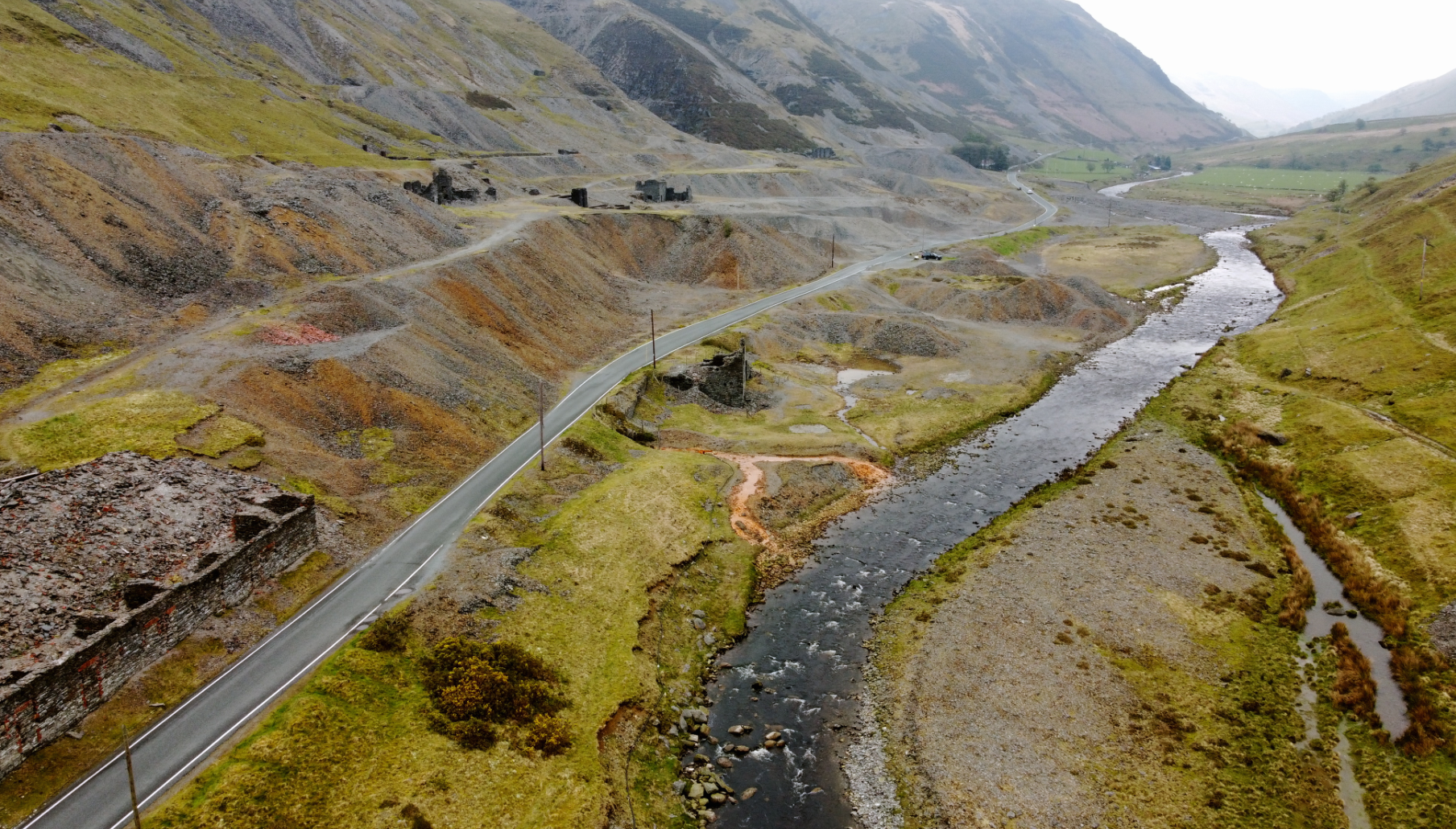Cwmystwyth Lead Mine
Overview

Cwmystwyth Mine is approximately 6km northeast of the village of Pont-rhyd-y-groes, Ceredigion.
Background
The mine covers around 250ha on the steep northern slopes of the Ystwyth Valley, with some minor workings on the southern slopes.

Cwmystwyth exploited three mineral lodes over the course of its operation, namely Comet, Kingside and Mitchell.
The earliest mining at Cwmystwyth has been dated to the Early Bronze Age, when copper was extracted from the Comet lode in an opencast on Copa Hill.
The mine was worked intermittently from this time, at varying profitability, until finally being abandoned in 1950. The remains at Cwmystwyth are extensive and include vast waste dumps, a large opencast, ruinous buildings, shafts, adits and leats.
The River Ystwyth receives all surface and sub-surface drainage from the mine. This adds approximately 12 tonnes of zinc, 2 tonnes of lead and 30 kg of cadmium to the river each year.
This input of metals contributes to the River Ystwyth failing its Water Framework Directive standards for zinc, with zinc remaining elevated downstream of the mine as far as the sea at Cardigan Bay. The metal inputs also detrimentally impact fish and invertebrate populations.
Project Progress
Over the past few years, we have been gathering information to better understand the pollution sources from Cwmystwyth Mine and to identify potential intervention options.
In 2020 we completed a Feasibility Study to collate relevant information and develop an Outline Design to maximise pollution prevention and other environmental benefits, whilst considering costs and designation constraints such as ecological / heritage protections.
We have also completed ground investigations, heritage, ecological and landscape assessments, topographical and geophysical surveys, and further targeted water quality monitoring. This information has been used to refine the Outline Design.
A combination of the potential options presented below will be needed to successfully manage the range of pollution sources at Cwmystwyth Mine.
We welcome your input as we continue to develop our options, as well as any wider environmental, social and economic opportunities available.
Possible Mitigation Options
Possible Mitigation Options
- Watercourse management e.g. separation
- Surface water management e.g. mine site drainage
- Spoil heap erosion controls
- Mine waste reprofiling with/without capping
- Mine Water Treatment
- Sediment control
Mining Heritage and Ecology
The Cwmystwyth Mine sits within an area of high archaeological and ecological sensitivity relating to the mine and its associated spoil heaps.
These include ecological features of interest within the Mwyngloddiau Cwmystwyth Site of Special Scientific Interest (SSSI). A number of rare plants grow on the metal-rich spoil heaps, including lichens and bryophytes which form ‘Calaminarian Grassland’ habitat.
The mine is also located within the Elenydd Special Area of Conservation (SAC) and borders the Elenydd-Mallaen Special Protection Area (SPA). Breeding birds of importance which have nest sites within the SPA include the red kite, peregrine falcon and merlin.
Cwmystwyth Mine is linked via the AfonYstwyth to further ecologically sensitive areas downstream on both the river itself and on the coast, where it discharges into sensitive marine habitats in Cardigan Bay.
The entire mine site, including underground workings, is designated as a Scheduled Monument. The mine is owned by Cambrian Mines Trust (CMT), who were formed to purchase and preserve Cwmystwyth Mine in 2012.
The mine is recognised as one of the most important metal mining sites in Wales. CMT is striving to preserve and promote the cultural and archaeological features of the site, so that it can be better appreciated by the wider public.
Further information on Cwmystwyth Mine and the work of CMT can be found here: www.cambrianmines.co.uk
Next Steps
The Outline Design of intervention and remediation measures identified by the Feasibility Study will be further developed, including consultation with stakeholders, before applying for planning permission and other regulatory consents required.
This will be a phased strategy, with design and construction of enabling works (surface water and watercourse management) followed by 12 months monitoring; the results of which will be used to refine the design of the mine water treatment system (MWTS).
The construction, commissioning and operation of the MWTS is the final phase for the long-term management of the pollution sources. An indicative timeline is presented below, this is subject to securing the required funding.
We would like the local community and other stakeholders to play a key part in this process. We will be holding public consultation events later in the project and issuing regular newsletters.
Current Timeline
Newsletters
Further Information
Keeping in touch and how to get involved
We want to hear from you as we progress the Cwmystwyth Mine Project and explore the wider environmental and social opportunities that can be developed as part of the preferred strategy for this site.
If you’d like to share your views, be added to an email mailing list, or have any questions please get in touch on the details below:
cwmystwyth@metalmineswales.co.uk

Areas
- All Areas
Audiences
- Metal mines
Interests
- Metal mines

Share
Share on Twitter Share on Facebook